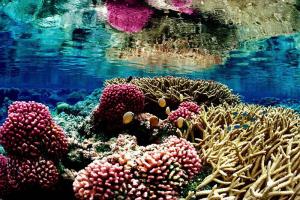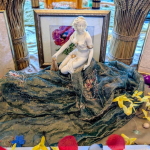
Amaterasu
Zooxanthellae,
microscopic algae,
live
in exquisite symbiosis
with coral reefs
pink, turquoise, happy yellow
in a narrow range
of temperatures
like Goldilocks’ porridge
(no stanza break)
—just right—
zooxanthellae
photosynthesize
fire red, apricot, lemon, jade
corals patiently craft
staghorns, spiral wires, pillars
it takes
millions
of years
peach and a blue bluer than dreams
building sea bones
ocean species
in the
millions
depend on
mossy green, pumpkin orange, splash of cranberry
zooxanthellae produce
oxygen, glucose, glycerol, amino acids
in water of depth
—just right—
in water that is
clean and clear
to feed
living bones of the sea
a snub-nosed turtle swims languidly
past aqua, mushroom brown, violet
coral polyps
fed by their partners
produce calcium carbonate,
build reefs—
shelter
one-fourth
of all
ocean life
dusty tan, magenta, swirling beige, pincushion gold
when water
warms
when water
suffers
acidification
stressed corals
evict tiny cells
that feed them
bleach
white
Sun Goddess, hide your face.
White is the color of death.
***
Coral reefs are much more than a pretty face.
Coral reefs are much more than a pretty face. They provide a home for a quarter of marine species on Earth, according to The Nature Conservancy. And they are in trouble.
To give voice to my concern about these delicate systems so vital to life, I wrote the poem, “Amaterasu,” in which I call upon the Japanese sun goddess to hide her face. Why? Because scientists say that global warming is the chief, although not the only, threat to these stunningly beautiful “protein factories of the world,” so-named by the American nonprofit, Conservation International.
Coral reefs need clean, clear water and temperatures of 70-85°F (22-29°C) to survive. But waters are warming, and the delicate balance among the miniscule creatures described in my poem is being disturbed. This is not the fault of Amaterasu, we know, but rather the rapid rise of greenhouse gasses such as methane and carbon dioxide in the atmosphere. NASA likens the effect to a thermal blanket that covers Earth and traps the sun’s warmth.
Corals feed off nutrients from their partner algae’s photosynthesis. Some corals live close to the surface in tropical waters so that the algae can access the sun’s rays.
One such habitat is found at Curaçao, an island in the southern Caribbean near Aruba. It is a popular spot for scuba divers to appreciate coral reefs.
“The reefs are suffering a huge degradation due to multiple facts, and the coral mass of the oceans is shrinking, which is really bad for the oceans,” says islander Pol Bosch, project manager of Coral Restoration Foundation Curaçao.
The foundation grows corals in nurseries, Pol says. “Then, when they are ready, we either cut them to repopulate our nurseries or we put them back in the reefs. We already restored 3,500 corals. And there’s a lot more to come.”
We admire the foundation’s work and during an email interview, asked Pol, who also is a manager at Ocean Encounters Diving, what ordinary landlubbers like ourselves can do to help corals.
“Any local change will eventually make a change globally,” he says. “Reduce any type of waste, especially plastic, which will unfortunately end up in the sea. Support any initiatives that will help reduce or revert the climate change, support ‘green energy’ and use as much as possible biodegradable products. Reduce, reuse, recycle.”
We as consumers have a tremendous amount of power. We can just say no to plastic grocery bags and carry our own reusable cloth bags to the store. One green bag I bought recently at my grocer’s for only $2 has a cardboard slab in the bottom which makes it easier to bag the groceries. No need to add to the enormous masses of floating plastic in the sea that are choking marine life.
If you use sunscreen, Pol recommends buying eco-conscious, reef-friendly products that are mineral-based and don’t use oxybenzone, which, he adds, “is extremely bad for coral.”
Do you enjoy eating seafood?
Studies on the future of seafood are alarming and range from a prediction that seafood will disappear within 30 years to 90 percent of the world’s fisheries are already fully exploited.
To eat seafood responsibly and help keep oceans healthy, visit the Monterey Bay Aquarium’s Seafood Watch website. Its printable guides are broken down by region, so you can find ocean-friendly seafood wherever you live or travel. The site recommends, “Look for the Marine Stewardship Council (MSC) blue ecolabel in stores and restaurants. These products are certified sustainable to the standards of the MSC and can be traced back to the certified fishery.”
On the site you’ll find apps you can download and a place to sign up for its emailed newsletters.
Education is our first line of defense. I learned a lot researching material for this piece. For instance, I often feel overwhelmed when I ponder how to reduce my carbon footprint. But when I start learning more, I find astounding information. Here’s one useful tip I learned: One person eating one vegetarian meal a week for a year would save the greenhouse gas equivalent of driving 1,160 miles less!
I read this in Livia Albeck-Ripka’s piece, “How to Reduce Your Carbon Footprint,” inThe New York Timesseries, “A Year of Living Better.”
I went to the cupboard and pulled out a bag of black beans and set them on the kitchen counter where they’ll remind me to soak them tonight. Tomorrow night, we’ll have bean soup with roasted garlic, veggies and homegrown basil.
Visit Nan, author of a book of poems, Gaia’s Cry, at nanlundeen.com

















